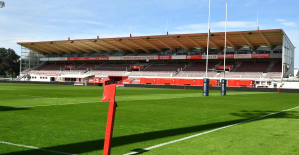Black flags hang from bare window sockets onto the empty street, on which stands only a leafless tree and a black cat with its tail cocked in fear: Felix Nussbaum's painting "Rue triste" (in German "Desolate Street") is depressing. Until now it was considered a visionary premonition of death; the catalog raisonné of the artist, who was murdered in 1944 in the Auschwitz concentration camp, dates it to 1928. A high-tech investigation now shows that the picture must have been taken at the end of 1938 or beginning of 1939 and should therefore be Nussbaum's reflection on the November pogroms, better known but imprecisely as "Reichskristallnacht". represent.
Nussbaum, born at the end of 1904 as the son of wealthy Jewish parents in Osnabrück, had left his adopted home of Berlin in 1932 to take up a scholarship as an artist at the Villa Massimo in Italy. He did not return to Germany, because Hitler had ruled there since the end of January 1933. Nussbaum was stripped of his state grant and had to emigrate to Belgium via Switzerland and France. He lived here until the Wehrmacht attacked in May 1940, when he was interned and deported to southern France. Nussbaum managed to escape from the St. Cyprien camp, then returned illegally to Brussels and lived underground there, supported by non-Jewish friends.
In mid-1942, Nussbaum hid his painting "Rue triste" along with many other paintings at his dentist Grosfils. In complete isolation and in constant danger of being discovered and deported, he himself created other works of art that are impressive testimonies to the psychological pressure on persecuted Jews.
On June 20, 1944, he and his wife Felka were arrested in their hiding place and taken to an assembly camp. From there they were deported to Auschwitz on July 31. A file from the infirmary in the Auschwitz main camp from September 20 lists the name of Felix Nussbaum; in the following months he must have succumbed to the unbearable living conditions in the concentration camp. In any case, he did not live to see the liberation of the camp in January 1945.
It was not until the late 1960s that Auguste Moses-Nussbaum, the painter's cousin, rediscovered the painting "Rue Triste"; since 2008 it has been on permanent loan at the Center for Persecuted Arts in Solingen. For the exhibition "1929/1955" about the beginnings of the documenta in Kassel, the painting was examined at the Institute for Restoration and Conservation Science at the Technical University of Cologne using X-rays and infrared light. This allows earlier layers to be made visible.
The result was surprising: "Rue triste" is painted over a previously lost work by Felix Nussbaum, of which there are only two original sketches from 1938/39. From this, the Center for Persecuted Arts concludes: "The 'Rue triste' is Felix Nussbaum's reaction to the pogrom night of November 9, 1938."
The former journalist (among others at WELT) and collector Jürgen Serke, who owns and lenders the painting, said of the find: "A sensational discovery! I've always had the feeling that this picture hides a secret. Now it's aired."
The two known preliminary drawings (today in Yad Vashem and in the Jewish Museum in Frankfurt/Main) show people in a landscape of ruins. You are still associated in the catalog raisonné with the invasion of Poland in September 1939. But that cannot be, because Nussbaum had painted a version of it in oil under the motif of "Rue triste" - and "Rue triste" was shown for the first time at his exhibition in Brussels. On this occasion, the Dutch newspaper "Nieuwe Rotterdamse Courant" mentioned the picture on February 11, 1939, almost seven months before the attack on Poland. "Rue triste" can therefore only have been created after the oil version of the two preliminary drawings, which Nussbaum immediately painted over again.
The director of the Solingen Museum, Jürgen Joseph Kaumkötter, considers the November pogroms to be the reason for Nussbaum's first apocalyptic, then desolate portrayal: "There is no other event to which one can connect it." In fact, the evidence speaks for it. This would make "Rue triste" one of the earliest artistic depictions of the organized attacks that began in the late evening of November 9, 1939 in Munich, covered the entire German Reich in the hours that followed and continued until November 11, in some places even more stopped or flared up again by the 13th.
During this time, National Socialists of all ages took action against the Jewish population in at least 1,400 towns and cities. Almost all synagogues and prayer rooms on German soil were desecrated or set on fire, and tens of thousands of homes and businesses were looted. Following the state-sponsored assaults, the Gestapo, SS, and police deported some 31,000 male German Jews to Dachau, Buchenwald, and Sachsenhausen concentration camps.
You can also find "World History" on Facebook. We are happy about a like.

 United States: divided on the question of presidential immunity, the Supreme Court offers respite to Trump
United States: divided on the question of presidential immunity, the Supreme Court offers respite to Trump Maurizio Molinari: “the Scurati affair, a European injury”
Maurizio Molinari: “the Scurati affair, a European injury” Hamas-Israel war: US begins construction of pier in Gaza
Hamas-Israel war: US begins construction of pier in Gaza Israel prepares to attack Rafah
Israel prepares to attack Rafah Spain is the country in the European Union with the most overqualified workers for their jobs
Spain is the country in the European Union with the most overqualified workers for their jobs Parvovirus alert, the “fifth disease” of children which has already caused the death of five babies in 2024
Parvovirus alert, the “fifth disease” of children which has already caused the death of five babies in 2024 Colorectal cancer: what to watch out for in those under 50
Colorectal cancer: what to watch out for in those under 50 H5N1 virus: traces detected in pasteurized milk in the United States
H5N1 virus: traces detected in pasteurized milk in the United States Private clinics announce a strike with “total suspension” of their activities, including emergencies, from June 3 to 5
Private clinics announce a strike with “total suspension” of their activities, including emergencies, from June 3 to 5 The Lagardère group wants to accentuate “synergies” with Vivendi, its new owner
The Lagardère group wants to accentuate “synergies” with Vivendi, its new owner The iconic tennis video game “Top Spin” returns after 13 years of absence
The iconic tennis video game “Top Spin” returns after 13 years of absence Three Stellantis automobile factories shut down due to supplier strike
Three Stellantis automobile factories shut down due to supplier strike A pre-Roman necropolis discovered in Italy during archaeological excavations
A pre-Roman necropolis discovered in Italy during archaeological excavations Searches in Guadeloupe for an investigation into the memorial dedicated to the history of slavery
Searches in Guadeloupe for an investigation into the memorial dedicated to the history of slavery Aya Nakamura in Olympic form a few hours before the Flames ceremony
Aya Nakamura in Olympic form a few hours before the Flames ceremony Psychiatrist Raphaël Gaillard elected to the French Academy
Psychiatrist Raphaël Gaillard elected to the French Academy Skoda Kodiaq 2024: a 'beast' plug-in hybrid SUV
Skoda Kodiaq 2024: a 'beast' plug-in hybrid SUV Tesla launches a new Model Y with 600 km of autonomy at a "more accessible price"
Tesla launches a new Model Y with 600 km of autonomy at a "more accessible price" The 10 best-selling cars in March 2024 in Spain: sales fall due to Easter
The 10 best-selling cars in March 2024 in Spain: sales fall due to Easter A private jet company buys more than 100 flying cars
A private jet company buys more than 100 flying cars This is how housing prices have changed in Spain in the last decade
This is how housing prices have changed in Spain in the last decade The home mortgage firm drops 10% in January and interest soars to 3.46%
The home mortgage firm drops 10% in January and interest soars to 3.46% The jewel of the Rocío de Nagüeles urbanization: a dream villa in Marbella
The jewel of the Rocío de Nagüeles urbanization: a dream villa in Marbella Rental prices grow by 7.3% in February: where does it go up and where does it go down?
Rental prices grow by 7.3% in February: where does it go up and where does it go down? Even on a mission for NATO, the Charles-de-Gaulle remains under French control, Lecornu responds to Mélenchon
Even on a mission for NATO, the Charles-de-Gaulle remains under French control, Lecornu responds to Mélenchon “Deadly Europe”, “economic decline”, immigration… What to remember from Emmanuel Macron’s speech at the Sorbonne
“Deadly Europe”, “economic decline”, immigration… What to remember from Emmanuel Macron’s speech at the Sorbonne Sale of Biogaran: The Republicans write to Emmanuel Macron
Sale of Biogaran: The Republicans write to Emmanuel Macron Europeans: “All those who claim that we don’t need Europe are liars”, criticizes Bayrou
Europeans: “All those who claim that we don’t need Europe are liars”, criticizes Bayrou These French cities that will boycott the World Cup in Qatar
These French cities that will boycott the World Cup in Qatar Archery: everything you need to know about the sport
Archery: everything you need to know about the sport Handball: “We collapsed”, regrets Nikola Karabatic after PSG-Barcelona
Handball: “We collapsed”, regrets Nikola Karabatic after PSG-Barcelona Tennis: smash, drop shot, slide... Nadal's best points for his return to Madrid (video)
Tennis: smash, drop shot, slide... Nadal's best points for his return to Madrid (video) Pro D2: Biarritz wins a significant success in Agen and takes another step towards maintaining
Pro D2: Biarritz wins a significant success in Agen and takes another step towards maintaining


















